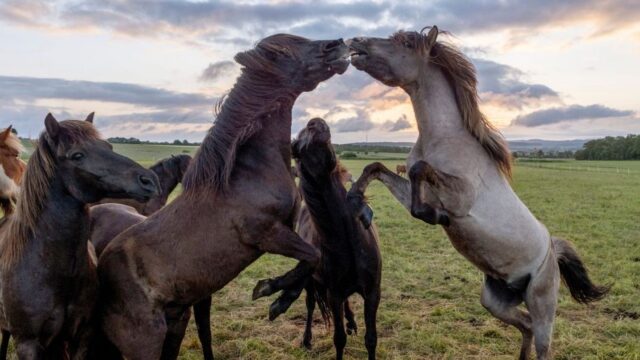Just a few minutes of aerial recording can help draw conclusions about the past and future of threatened species
Hungarian researchers they use drones to follow the movements of a herd of almost 300 horsesin danger of extinction. Przewalski’s horses live on remote plains, far from human interference.
These wild horses became extinct in their natural habitat, but thanks to captive breeding programs There are about 2,000 Przewalski horses that once again roam freely.
Przewalski’s horses have harems within their herds
A herd of 278 horses lives in the Hortobágy National Park (Hungary). Someday they could be released. Researchers from Eötvös Loránd University and the University of Debrecen fly to better understand social systems of these beautiful animals.
During the observations, scientists use two drones: one that flies above the pack and another that approaches to be able identify each animal. “The scientific study of Przewalski’s horses is really interesting,” explains Máté Nagy from Eötvös Loránd University.
“They have this hierarchy, that is, the whole herd moves together and within the packs, there are the harems and within the harems, there are the family ties and then the individuals. And so we wanted to understand this system,” he adds.
What are Przewalski horses?
Przewalski’s horses are considered the last horses truly wild animals left on the planet, since other specieslike the American Mustang, descend from domesticated animals. This species was once common in the vast steppes of Central Asia.
When they were discovered by the Russian geographer Nikolai Przewalski in 1879, their habitat had been reduced to a small area in western Mongolia. The cattle competitionhuman activity and changes in your environment They had practically exterminated them. After World War IItheir numbers were so low that it became evident that they might become extinct in the wild.
Why did researchers use drones?
Using them classical observation methods to examine the social behavior of a large group of animals is “laborious” and “time-consuming.” “Some of what we are trying to implement in the future is artificial intelligence to actually replace these really laborious jobs that humans did,” explains Nagy.
Researchers say that even some few minutes of aerial recording can provide sufficient information for specialists to know the esocial structure of the population and even draw conclusions about the past and future of the group’s dynamics.
With the help of aerial images, they have been able to demonstrate that these horses Wild people live in a complex and multi-segmented society.
In the first years after the introduction of the packthe harems (bands led by males) of wild horses They stayed away from each other within their own territory and rarely interacted.
However, in recent years, the harems have gathered together to form a large pack in which they can still distinguish individual haremsbut they move together through the reserve territory.
Researchers have discovered that individuals in the group coordinate their movements and align with each other through subtle interactions. The multilevel social structure displayed by wild horses is rare in the animal world and occurs more commonly in primates.
Their analysis has shown that the social relationships of horses wild animals are related to kinship and previous acquaintances. For example, mares are closer in the social network of other mares with those who have spent more time in the same harem.
Kinship may also play an important role in organizing harems into herds, as harems of sibling stallions are closer to each other in the social network than harems of unrelated stallions.
They also found that harems that have existed for a long time and have more members occupy a more central place in the social network of the pack. By analyzing the movementsit was also possible to conclude which mares will leave their harem in the next two years and to which harem they will move.
Przewalski’s horse went from be in serious danger of extinction became extinct in the wild in 2008. Three years later its status was changed to endangered. The IUCN Red List go on classifying the species as “In danger.” Despite the success of captive breeding programs, the lack of genetic variety in this tiny and dispersed population means that they remain very vulnerable.







